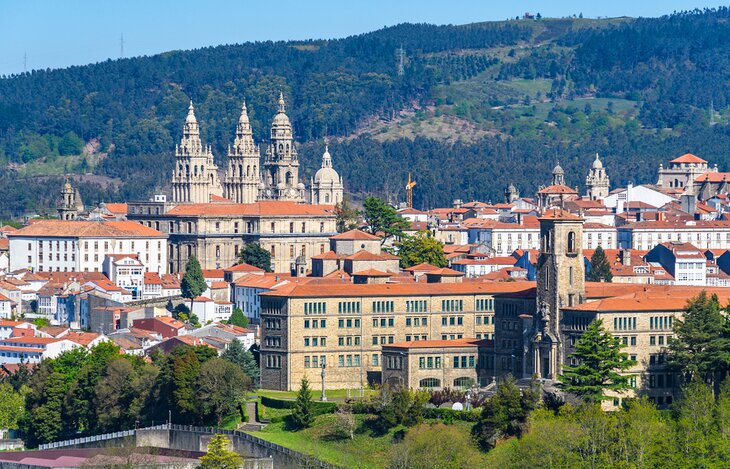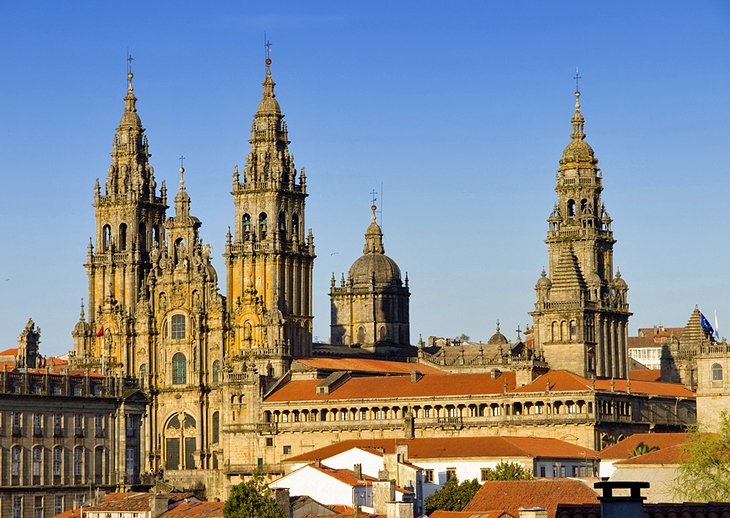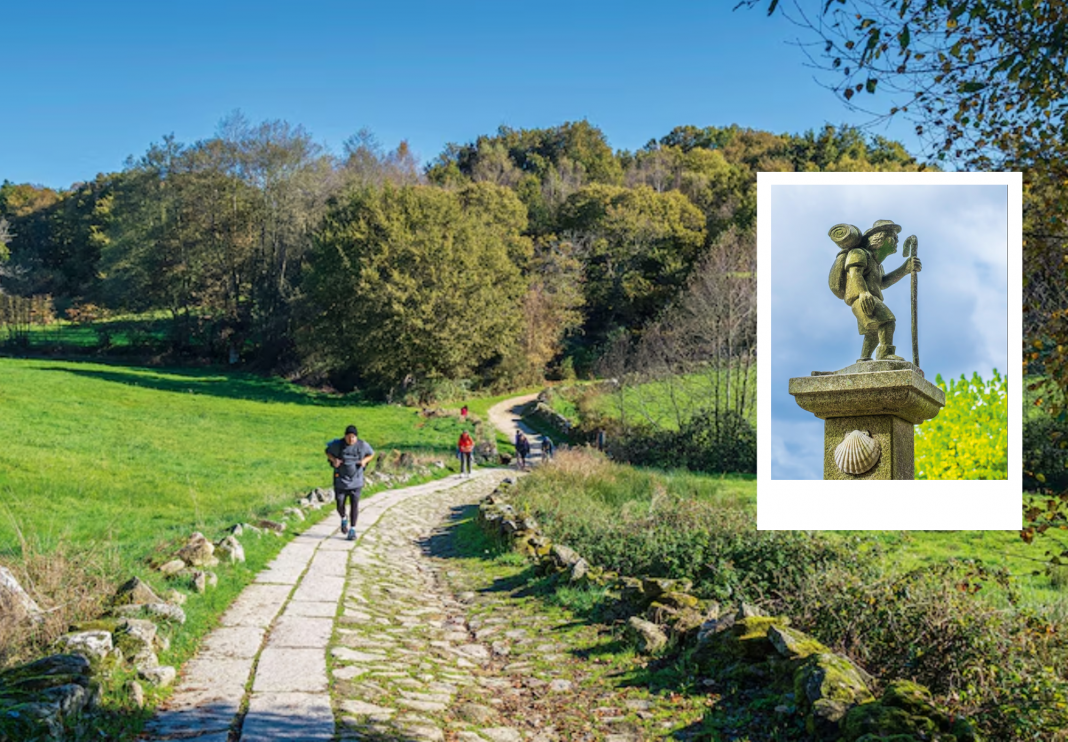Some cheer, others weep. A few pilgrims quietly clasp one another’s shoulders while others collapse onto the cobblestones, backpacks turned into makeshift pillows. The journey is over. Before them, the twin towers of Santiago de Compostela Cathedral soar toward the sky — their worn faces lit by the soft Galician sun. Some kick off their walking boots, others simply lie on their backs and stare. There’s nowhere else to go. “Lying in the Praza do Obradoiro is a tradition,” says Maria Guerra Gomez, a local guide with 1 2 Tours, as we watch pilgrims bask in quiet triumph. “I did it too — and thought the cathedral would topple over on top of me.” Her smile is warm and wide, her dark curls bouncing with each nod. She speaks with reverence, not just about the cathedral, but the city itself — a place where the past lives not only in stone, but in spirit.
Where a legend became a movement
Santiago de Compostela is the capital of Galicia, a lush region tucked in Spain’s northwest corner, often cloaked in mist and rain. But its identity is built on fire — or rather, a legend sparked by mysterious lights in a forest. The story goes that in the 9th century, a hermit followed strange celestial glimmers into the woods and discovered the tomb of St James the Great — Santiago in Spanish — one of Jesus’ closest disciples.
The discovery changed everything. A modest shrine was built, later replaced by the grand cathedral we see today. Pilgrims began arriving from across medieval Europe, walking for weeks or even months to see the relics. Thus was born the Camino de Santiago — The Way of St James — a network of ancient paths that still draws people in, centuries later.

In 2024, the Camino saw a record half a million pilgrims complete the journey, walking or cycling the required 100 or 200 kilometers to earn their certificate. But today, many come not for religious reasons alone. The Camino has evolved into something broader — a moving meditation, a physical challenge, or a journey of healing.
A spiritual city beyond the cathedral
Though the cathedral remains the heart of Santiago, spirituality hums through the city’s very stones. Inside the church, pilgrims still follow the centuries-old ritual: they descend into a crypt to view the silver casket said to hold Santiago’s remains, then ascend behind the altar to embrace his statue. “It’s very intimate,” says Maria, as we watch a man rest his head against the bust in silent communion.

The sacred spills beyond the cathedral walls. In the Old Town, Benedictine nuns sell almond tarta de Santiago through a hidden revolving window at the Monastery of San Paio. Guests can stay in the monastic complex of San Martín Pinario, where rooms are austere but peaceful — iron beds, wooden desks, and an almost monastic calm. “Some traditions haven’t changed,” Maria notes as we walk cobbled streets slick from the morning drizzle. “This city still belongs to the pilgrims.”
The path as prayer
Each pilgrim walks for their own reason, but almost all are changed by the experience. On the square, I meet a Polish graduate who likens each day of the Camino to the rhythm of a Catholic prayer. A Dutch writer tells me she walked to let go of the past and set intentions for the future. One young French woman started from her front door. A Swiss man didn’t stop once he arrived — he just kept walking.
Maria’s own story is no less poetic. Born in the Canary Islands to a Galician mother, she first came to Santiago at the end of her own pilgrimage. “It welcomed me,” she says. “I felt like I’d returned to medieval times. Maybe that’s how pilgrims have always felt — connected to something bigger.”
A marketplace of culture and flavor
Spiritual nourishment is one thing — but Santiago offers the other kind, too. Just steps from the cathedral lies Mercado de Abastos, a stone-built market that feels like a cathedral itself: granite arches, long vaulted aisles, and a reverent quiet broken only by the hum of trade. “The architect wanted to create a cathedral of products,” Maria tells me, handing over a slice of creamy tetilla cheese, shaped like a small breast and made from Galician cow’s milk.

Galicia’s bounty is on full display — velvet crabs, bright-orange chorizo, thick coils of octopus, and percebes, the delicate, claw-like goose barnacles prized on Spanish tables. Most evocative of all are the scallop shells — the symbol of the Camino — sold, cleaned and polished, still smelling faintly of the sea. “Food is a cult here,” Maria says, nodding toward crates of cachelos (potatoes) and grelos (turnip greens). “It’s part of our soul.”
Green serenity in a rainy land
With its frequent rains and emerald hills, Santiago de Compostela feels more like Wales than southern Spain. In fact, it has one of the highest ratios of green space per person in the country. After parting ways with Maria, I find myself drawn to Parque de San Domingos de Bonaval — a former convent estate turned public park.

At the top of an oak grove, I stop. Below me, the city’s grey rooftops shimmer under a veil of mist. The cathedral towers still rise, but now they are distant and quiet. It’s hard not to be moved by the view — by the idea that this city exists because people kept walking toward it, generation after generation.
I sit, then lie back on the damp grass. Like the pilgrims in the square, I stare upward, letting my thoughts stretch. The story of Santiago is full of legends — some true, some imagined — but what remains undeniable is the city itself, shaped by faith, fatigue, and the will to keep going.
How to do it
Tour: 1 2 Tours offers customizable private walking tours of Santiago, including historic and gastronomic routes.
Stay: Hospedería San Martín Pinario offers monastic-style rooms in the heart of the Old Town. Doubles from €149 (£125).
Getting there: Santiago de Compostela Airport is about a 20-minute taxi ride from the city centre. Pre-book transfers, especially during the high season (July–September).



